XMPP vs WebSocket: Which Is The Best For Your Chat App?
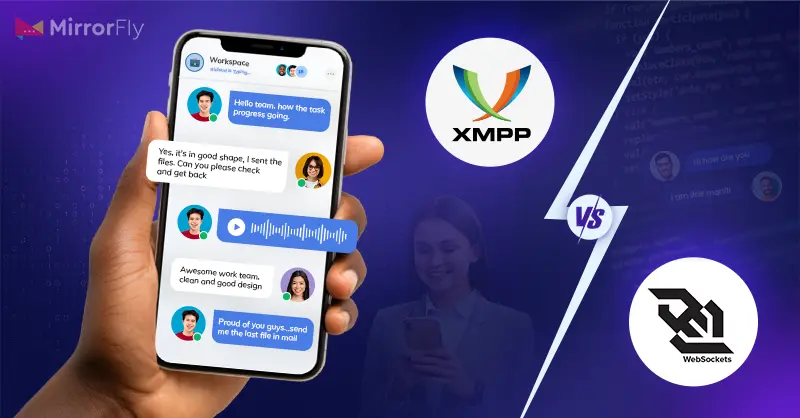
Explore the differences between XMPP vs WebSockets and figure out which one is best for your chat app development.
XMPP and WebSocket are two different technologies used for real-time communication between clients and servers. While both these protocols are used for the same purpose, they differ from each other in multiple ways.
This article will walk you through:
- A basic understanding of XMPP and WebSocket
- How do they operate in your chat app?
- Which protocol is right for you?
This is going to be interesting. Explore the differences between XMPP and WebSocket in the next few minutes ahead!
Table of Contents
What is XMPP Protocol?
XMPP (Extensible Messaging and Presence Protocol) is a communication protocol that enables exchange of messages in real-time. This protocol is more about the format and behavior of messaging applications rather than their transport mechanism.
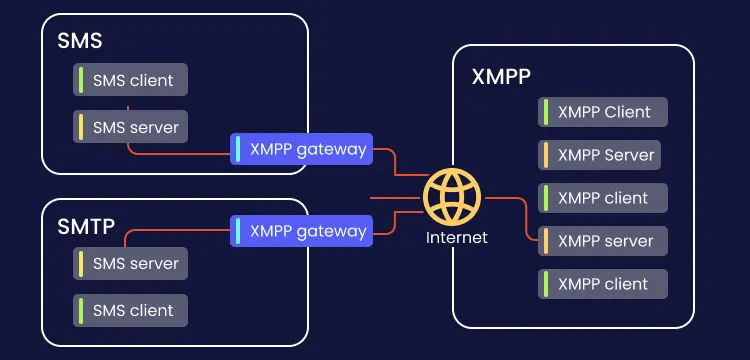
Precisely, XMPP protocol ensures real-time message delivery by leveraging protocols like TCP, HTTP, or WebSocket. When considering XMPP over WebSocket, developers prioritize XMPP for its advanced messaging functionalities and WebSocket for high-speed data transfer.
While XMPP uses an asynchronous push mechanism for message delivery, comparing the XMPP protocol vs WebSocket highlights XMPP’s strength in modular messaging features, whereas WebSocket stands out for fast and lightweight real-time communication.
In general, the recipient client must regularly send requests to the server at fixed intervals to check if there are any new messages or updates. This is what we call ‘Client Polling’.
But, with XMPP, the server proactively pushes the messages to the recipient client.
This saves a lot of bandwidth and makes message delivery faster. Plus, the message delivery is maintained in the chronological order.
The only drawback is that XMPP does not provide a default option to know if a message was delivered or not. You may need to implement additional features or use XMPP extensions to get delivery receipts.

- Lifetime Data Ownership
- Deploy on Own Server
- Hire Dedicated Developer
Core Protocol Methods Of XMPP
When you use XMPP, it enables message exchange between your user devices, shows them the ‘online’ or ‘offline’ status of other users and various other messaging functionalities.
Now to make all these happen, the XMPP uses a few important protocols that act as the foundation of the entire protocol mechanism.
A few of them include:
- Setup and teardown of XML streams: This method is used when the XMPP needs to establish or close the XML streams for data exchange between clients and servers.
- Channel encryption: To protect user conversations between user endpoints, XMPP supports channel encryption using Transport Layer Security (TLS).
- User Authentication: You need to authenticate your app users so that the conversation that happens on your app will happen only between authorized individuals. This is where XMPP uses the Simple Authentication and Security Layer (SASL) to authenticate users, before they can start chatting on your app.
- Error handling: Sometimes, errors may happen during the communication process. XMPP is also used to handle these errors making sure your message delivery is spot on.
- Communication primitives: XMPP offers communication primitives for messaging, network availability (presence), and request-response interactions. This helps you easily implement real-time messaging, presence updates, and interactive communication between your app users.
Now, you know them all. But the interesting part is just ahead!
How Does XMPP Work In A Chat App?
When a Sender hits the ‘Send’ button, the message data reaches the server, the server sends the message to the intended recipient. That’s how it looks to us. But where does XMPP work here? What does it exactly do?
Let me explain this with a simple example.
John sends ‘Hi’ to Jessica.
Here John’s iPhone is the Sender Client and Jessica’s iPhone is the Recipient Client.
| What Happens At The Backend? | What Happens In Real-time? |
|---|---|
| The Sender Client initiates a TCP connection to the XMPP server | John’s messaging app on his iPhone connects to the XMPP chat server using a TCP connection. |
| Server authenticates the client and establishes an XML stream | The XMPP server verifies John’s identity and sets up a secure XML communication channel with his app. |
| Client sends messages to the server using XML-formatted stanzas | John types and sends “Hi” to Jessica in the chat app. The message is formatted into an XML stanza and sent to the server. |
| Server routes the messages to the intended recipients | John’s “Hi” message is packaged into an XML format and transmitted over the established TCP connection to the server. |
| Clients send presence stanzas to indicate online/offline status of other clients | The XMPP server receives John’s XML message and forwards it to Jessica’s client based on her online status and subscription. |
| XMPP supports multiple client connections per user. It enables features like group chat, multi-user chat rooms, and broadcast messaging | Jessica’s chat app, subscribed to John’s presence, receives a notification that he is online and has sent a message. |
| XMPP can include plugins that can add support for asynchronous messaging, pub/sub systems, or file transfer. | The XMPP server manages John’s connection along with many others, ensuring his message reaches Jessica while maintaining all active connections. |
| XMPP provides strong security with TLS encryption and SASL authentication. | If the chat app uses XMPP plugins for features like end-to-end encryption, they process John’s message before delivery to Jessica. |
So, that’s exactly how XMPP works in a chat app, for real-time communication. Now is the time to find out what are the strengths and weaknesses of this protocol.
XMPP: Key Highlights Of The Protocol
- XMPP is built with a modular architecture. This means, you can add new features and functionalities without altering the core protocol. You can create extensions (XEPs – XMPP Extension Protocols) to introduce new capabilities, such as file transfer, gaming, IoT support, etc.
- Whether it is a simple one-to-one messaging or a high volume user communication, XMPP supports it all, in a variety of message formats.
- The protocol is based on open standards developed by the Internet Engineering Task Force (IETF). This means anyone can contribute to and use the protocol without licensing fees or proprietary restrictions.
Top Drawbacks Of XMPP
- The only drawback why a few developers refuse to use XMPP is because it does not support binary data. It can only handle XML stanzas.
- When comparing WebSocket vs WebRTC, WebSocket is ideal for bidirectional communication like text or data exchange, whereas WebRTC excels in real-time media streaming for voice and video communication.
What is WebSocket Messaging Protocol?
A Websocket is a communication protocol that enables persistent two-way communication between servers and clients by using the underlying TCP connection.
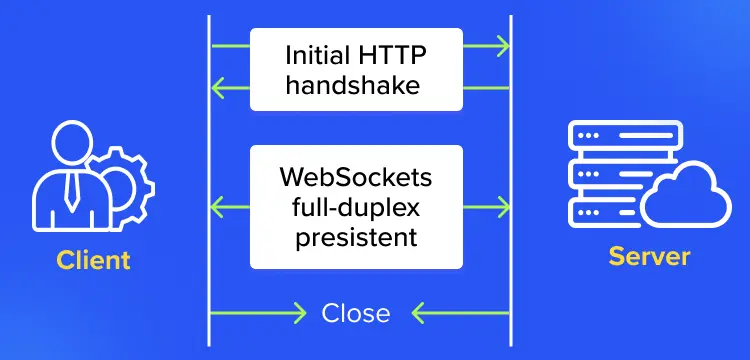
This protocol is the reason how messages are sent and received back and forth between users without any trigger actions at the backend. Behind the scenes, Websocket keeps the connection between the server and client open, eliminating the need for clients to request the message data to the server.
Core Protocol Methods Of WebSocket
Just like XMPP has its own methods, WebSocket does use various dedicated methods to establish and manage conversations in a chat app. Here is a quick walk-through of the methods you may use at the backend of your app when using Websocket for real-time communication.
- socket.send(data):
XMPP completely supports XML data. But WebSocket can cover strings or binary data. When a WebSocket connection is established, the socket.send(data) is used to send the messages.
- socket.close([code], [reason]):
Now, if the app has to terminate the WebSocket connection between the client and the server, this method is used with optional parameters like a status code and a reason for closing the connection.
This simply structures the way Websocket handles the closure of the communication channel.
- Events:
There are going to be different events happening at the backend when the communication happens.
Some of the key events include open (connection established), message (data received), error (error handling), and close (connection closed). These trigger actions for which you may need to respond at different stages of the WebSocket lifecycle.
How Does WebSocket Work In A Chat App
| Backend Process | Real-Time Scenario Explanation |
|---|---|
| Client initiates a WebSocket handshake with the server over HTTP. Server upgrades the HTTP connection to a persistent WebSocket connection | John’s messaging app connects to the chat server using a special handshake, like a secret greeting, to start talking directly. |
| Client and server can send messages asynchronously over the WebSocket connection, in text or binary format. | John quickly sends “Hi” to Jessica, and the message zips through the connection to her, just like a text message. |
| WebSocket are highly scalable and can handle a large number of simultaneous connections, eliminating the need for repeated HTTP requests. | The chat server effortlessly manages many conversations at once, ensuring John’s message reaches Jessica without delays. |
| WebSocket provide full-duplex communication, allowing clients and servers to send messages simultaneously | John and Jessica can talk back and forth simultaneously, like having a smooth conversation where both can speak at the same time. |
| Persistent connections and low overhead make WebSocket suitable for high-volume data transmission | Messages travel fast between John and Jessica, ensuring they can chat without waiting long for their messages to reach each other. |
| XMPP can use WebSocket as a transport protocol. Combining XMPP’s messaging and presence functionalities with WebSocket persistent connections provides a secure, flexible, and fast chat platform | By using WebSocket alongside XMPP, the chat app creates a secure, fast, and flexible platform for John and Jessica to chat in real-time. |
WebSocket: Key Highlights Of The Protocol
- Once a WebSocket connection is established, both the client and server can send messages to each other at any time, without waiting for a request/response cycle. Whereas in a HTTP connection, the client must initiate each request.
- As soon as data is available, WebSockets initiate immediate data transfer, minimizing delays (low latency) and making your app ideal for real-time communication.
- With Websockets, apps can handle continuous streams of data (e.g., live chat, stock tickers, online gaming) more efficiently.
Top Drawbacks Of WebSocket:
- Websocket are responsible for persistent connections. But maintaining this continuous stream of connection can be more complex, especially when dealing with issues like reconnections, connection timeouts, and session management.
- Unlike XMPP, Websocket does not provide any messaging or presence functionalities.
Alright, we’ve seen the basics on both XMPP and Websocket. Now is the time to compare both these protocols and find out which one of these is best for your chat app development project.
XMPP Vs WebSocket: An In-depth Comparison
Although both XMPP and WebSocket are used for real-time communication, they differ from each other in multiple ways in terms of how they work on your apps. Let’s take a look at each factor to understand the protocols even better.
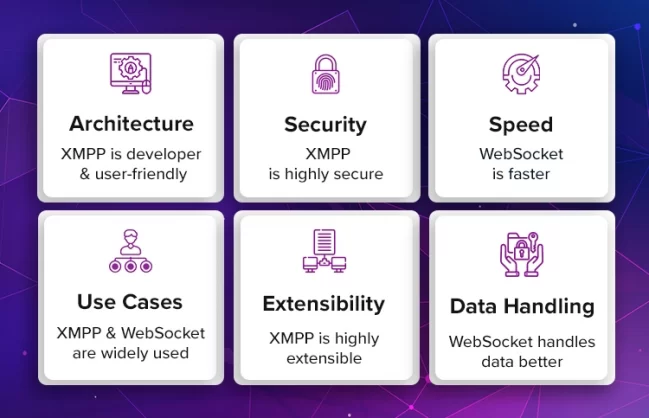
1. Architecture and Design
XMPP (Extensible Messaging and Presence Protocol) and WebSocket differ from each other in multiple ways in terms of how they are built and designed.
When comparing the XMPP vs WebSocket, XMPP utilizes a client-server model for secure, decentralized communication, while WebSocket focuses on peer-to-peer models for high-speed, simultaneous messaging. As a real time chat protocol, XMPP is used to handle errors, making sure your message delivery is spot on.
Based on its architecture,
– XMPP is used for long term connection between the clients and the server
– WebSocket is used to establish direct connections with servers and enable simultaneous message exchange between both parties.
2. Security
When it comes to security, XMPP and WebSocket take different approaches.
XMPP has robust, built-in security mechanisms, while WebSocket majorly rely on the transport layer (TCP) for security.
Now, let’s start with authentication.
XMPP natively supports authentication protocols like SASL and SCRAM, providing various methods including username/password and client certificates. WebSocket, however, does not have a native authentication mechanism and relies on the transport layer.
Next, when it comes to encryption, XMPP mandates TLS encryption for server-to-server communication and recommends it for client-to-server communication. On the other hand, WebSocket depends on the underlying transport layer for encryption.
XMPP has a built-in access control and authorization model based on JIDs and presence subscriptions, allowing control over who can communicate and what actions are permitted. Whereas, WebSocket lacks a standardized access control mechanism, demanding implementation at the application level.
Furthermore, XMPP has a rich set of security extensions like OMEMO and OX for end-to-end encryption. While WebSocket can integrate with technologies like WebRTC for end-to-end encryption, they do not have standardized security extensions.
Lastly, XMPP’s federation model allows secure communication between different XMPP servers based on trusted domains and server-to-server authentication. WebSocket lacks a standardized federation model, making it a need to gain customer trust and authentication mechanisms for secure communication between different servers or applications.
Overall, XMPP offers more robust and integrated security features out-of-the-box, while WebSocket heavily relies on the transport layer and application-level implementations for security.
3. Speed
Speed is one of the key factors that real-time chat apps can never be without. Of course, this real-time messaging software is the future of any business, and it’s the speed that talks about messages, delivers them on time, and grabs attention.
Now, with both XMPP and WebSocket, they are real-time chat protocols. Although the transmission speed is different for both of them,
Being decentralized in nature, XMPP has to continuously authorize and authenticate the server and client, increasing the bandwidth usage while slowly decreasing the connection speed.
But WebSocket is considered to be more centralized in nature due to its determined connection between server and client. To re-establish the connection over here, every time the data has been sent, it gives a large speed advantage to the WebSocket. Therefore, with transmission performance, it’s the WebSocket that has been proven to be the best.
From the above listing comparing the pros and cons of XMPP and WebSocket, I hope you’ll be now clear with the best option for developing your chat app.
However, the selection mostly depends on your demands, as what are you mostly looking out for in an instant messaging protocol? Let’s see.
4. Use Cases
Where Is XMPP Used?
- Instant Messaging and Chat Apps
Example: Jabber, WhatsApp (initially used XMPP)
XMPP is ideal for instant messaging apps as it supports real-time communication with various other features including presence information, contact lists, and real-time message delivery.
- Multi-User Chat (MUC)
Example: Slack
XMPP’s support for group chats through XEPs (XMPP Extension Protocols) like MUC makes group communication seamless.
- IoT (Internet of Things)
Example: Cisco’s IoT solutions
Most IoT businesses use XMPP to manage communication between devices and exchange of data securely in the necessary formats.
- Gaming
Example: Online multiplayer games for chat and presence
XMPP is used in gaming for in-game chat, player presence notifications, and real-time communication between players.
- Enterprise Communication
Example: Internal messaging systems in organizations
Companies use XMPP for workplace communication platforms to provide secure, scalable, and real-time messaging among employees.
- Federated Communication
Example: Cross-platform messaging systems
Wondered how your text from an iPhone gets delivered to an Android user? XMPP’s decentralized nature allows different servers to communicate easily and that’s how the message transfer happens.
Where Is WebSocket Used?
- Live Chat Support
Example: Intercom, LiveChat
If you evaluate WebSocket vs WebRTC, you can see WebSocket excels in low-latency, bi-directional communication ideal for live chat and instant messaging, while WebRTC focuses on peer-to-peer connections for media and data sharing.asynchronous
- Real-Time Updates and Notifications
Example: Facebook notifications, Twitter feeds
WebSocket enables real-time updates and push notifications to make it possible for users to receive the latest information without needing to refresh their browsers.
- Online Gaming
Example: Multiplayer online games
With its minimal latency, WebSocket supports real-time data transfer for online gaming for a smooth gameplay.
- Collaborative Editing
Example: Google Docs, Microsoft Office Online
WebSocket facilitate real-time collaborative editing by allowing multiple users to edit documents simultaneously
- Financial Trading Platforms
Example: Stock trading platforms, cryptocurrency exchanges
Financial platforms use WebSocket to provide real-time market data that makes it easy for traders to access up-to-the-second information.
- Real-Time Dashboards and Monitoring
Example: Data monitoring systems, server health dashboards
Websocket makes it easy for users to monitor system performance and access live analytics data with real-time data updates.
- Social Media Apps
Example: Chat features in social media apps
See those notifications on your social accounts immediately when someone likes your post or comments on it? Websocket is the reason!
- Streaming Services
Example: Live sports updates, live video calls, conferencing and streaming
The matches you watch and the videos you stream are right on your screen without any delays, by the power of WebSocket’s real-time communication capabilities.
5. Extensibility
XMPP has standard extensions called XEPs, developed by the XMPP Standards Foundation. These extensions cover a wide range of functionalities like file transfer, service discovery, and multi-user chat.
In contrast, WebSocket does not have a standardized set of extensions. However, they can integrate with other web technologies and protocols to extend their functionality.
Next, it is possible for XMPP to use application-level extensions through the development of custom XEPs. But WebSocket are relatively new protocols and there is no standardized mechanism for application-level extensions.
Lastly, XMPP’s federation model ensures interoperability between different XMPP servers and clients, even when using custom extensions. But WebSocket lacks a standardized interoperability model for custom extensions.
6. Data Handling
When it comes to data handling, XMPP uses XML while WebSocket can transmit arbitrary binary or text data.
In terms of message size and fragmentation, XMPP messages are limited in size due to its XML format. This is why you need to fragment and reassemble larger messages.
WebSocket, however, supports fragmentation and reassembly at the protocol level without the need for any additional mechanisms.
Where WebSocket has an advantage in data handling is during data compression. They use algorithms like Deflate or LZW to significantly reduce the amount of transmitted data, especially for text-based or repetitive payloads. On the other hand, XMPP lacks built-in compression support, which is quite a disadvantage.
When it comes to data serialization and deserialization, XMPP relies on XML which can be computationally expensive for large or complex data structures.
WebSocket, on the other hand, can utilize various formats like JSON or Protocol Buffers which are lightweight and efficient especially for structured data transmission.
Lastly, data validation and parsing differ between these two protocols.
XMPP messages need validation against XML schemas and parsing, adding overhead and complexity for large or deeply nested structures. WebSocket can make use of the existing libraries for chosen formats like JSON or Protocol Buffers.
7. Speed
Let’s start with latency – both protocols aim to minimize it by maintaining long-lived, persistent connections. However, there are differences in message overhead.
XMPP uses XML for encoding messages, which can add overhead due to its verbose nature, especially for small messages. WebSocket, on the other hand, can transmit arbitrary binary or text data, allowing for more compact message formats and reducing overhead for small payloads.
Protocol efficiency is something we need to consider next. XMPP has a more complex protocol stack with several layers of abstraction, while WebSocket operates at a lower level with a simpler protocol.
Regarding network and server load, XMPP’s client-server architecture can distribute load across multiple servers. WebSocket’s peer-to-peer model may put more load on individual servers, although load balancing and clustering can mitigate this issue.
Pros and Cons of XMPP
Before you decide which protocol you can choose for your chat app development, you need to clearly check the strengths and limitations.
So here is a breakdown for XMPP:
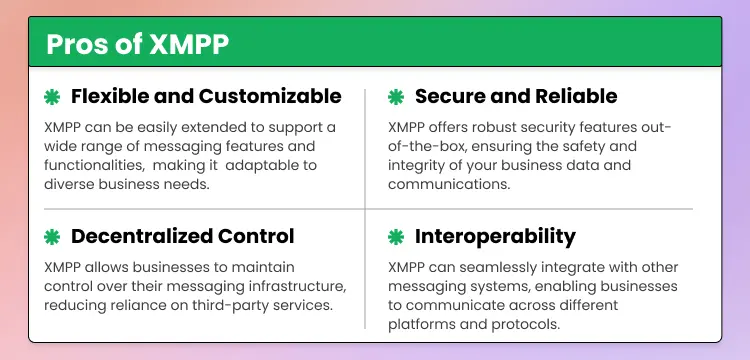
Here are the list of Xmpp Advantages
✅Flexible and Customizable: XMPP can be easily extended to support a wide range of messaging features and functionalities, making it adaptable to diverse business needs.
✅Secure and Reliable: XMPP offers robust security features out-of-the-box, ensuring the safety and integrity of your business data and communications.
✅Decentralized Control: XMPP allows businesses to maintain control over their messaging infrastructure, reducing reliance on third-party services.
✅Interoperability: XMPP can seamlessly integrate with other messaging systems, enabling businesses to communicate across different platforms and protocols.
And the reasons why XMPP might not be the best for you would be:

Xmpp Disadvantages
❌ Lack of QoS Guarantees: XMPP does not currently offer Quality of Service (QoS) guarantees for message delivery, which may be a concern for certain business-critical applications.
❌ Performance Concerns: XMPP may not be the best choice for applications that require high-speed data transfer or low-latency communication.
❌ Limited Data Format Support: XMPP primarily uses XML, which can be less efficient for certain types of data, such as binary files or large payloads.
❌ Potential Firewall Issues: Some corporate firewalls may block XMPP traffic, requiring additional configurations or workarounds.
Pros and Cons of WebSocket

WebSocket Advantages
✅Real-Time Communication: WebSocket enables efficient real-time, bidirectional communication between clients and servers, ideal for applications like chatbots, real-time notifications, or collaborative tools.
✅Efficient Data Transfer: WebSocket can transmit various data formats, including binary data, making them suitable for applications that require low-latency data transfer or large data payloads.
✅Cross-Domain Support: WebSocket allows communication between clients and servers on different domains, enabling businesses to build distributed applications more easily.
✅Event-Driven Model: WebSocket follows an event-driven model, enabling efficient handling of real-time events and data streams, suitable for applications like online gaming or real-time data visualization.
And the reasons why websocket might not be the best for you would be:

WebSocket Disadvantages
❌Proxy and Firewall Issues: Some proxies and firewalls may block WebSocket connections, requiring additional configuration or workarounds.
❌Security Considerations: WebSocket does not have built-in security features, requiring businesses to implement authentication and encryption mechanisms at the application level.
❌Scalability Challenges: While WebSocket can scale horizontally, their peer-to-peer nature may pose scalability challenges for applications with a large number of concurrent connections.
❌Browser Support: While WebSocket is widely supported in modern browsers, businesses may need to consider fallback mechanisms or polyfills for older browser versions.
Recommended Reading
Build A Real-time Chat App With XMPP & WebSocket
We know building a communication app is a huge responsibility. And understanding these protocols before using them can be a bit of work.
On the whole, it is advisable that you use XMPP over WebSocket to combine messaging and presence functionalities with secure and fast app performance.
Alright, you can bring all that you want in your app as we’ve discussed in this blog with unlimited customization offered by MirrorFly’s enterprise instant messaging software, 1000+ features, flexible deployment options (On-prem or On-cloud) and complete access to its source code.
Interesting right? For more details, talk to our experts today!
Get Started with MirrorFly’s Secure Chat Features Today!
Drive 1+ billions of conversations on your apps with highly secure 250+ real-time Communication Features.
Contact Sales200+ Happy Clients
Topic-based Chat
Multi-tenancy Support

Frequently Asked Questions (FAQ)
Yes, XMPP is a full-duplex protocol. Full-duplex means that data can be transmitted in both directions simultaneously, allowing for real-time bidirectional communication. When a client sends a message to another client through an XMPP server, it establishes a bidirectional communication channel between the two clients. This capability allows for interactive conversations, presence updates, and other real-time interactions.
XMPP operates over the Transmission Control Protocol (TCP) and does not use UDP. TCP ensures the ordered and error-free delivery of data packets and provides mechanisms for handling packet loss, retransmission, and flow control. It also is responsible for reliable delivery of XML-based messages and other data exchanged between clients and servers.
WebSockets is still a widely used technology and there is no specific technology that has replaced WebSockets. However, there are popular alternatives for Websockets for building real-time communication. They include Server-Sent Events (SSE), HTTP/2, WebRTC and MQTT.
Of course, XMPP is good at handling real time conversation but with WebSocket, it is a two-way computer communication protocol, a modern one over a single TCP. Even the usage of WebSocket is good with handling high scale transfer among server and client wherein, the connection between them will be maintained alive until terminated by either one.
To build your chat app, whether to go for WebSocket or XMPP, all depends upon your app’s requirements – If you are looking for high-end security, built-in presence and chat functionalities with a wide ecosystem of plugins, then XMPP is the better choice. But, if you are looking for multiple data types, mostly binary data to open multiple connections per user with speed-up data transmission, then WebSocket could be the better choice
However, when it is about the best technology used for a chatting application – both the technologies are good enough in it’s own way and choosing the best one depends on your chat app requirement. If your app is about high-end security and chat functionality with plugins that suit the environment, then XMPP could be the better choice. But, on the other hand, if you are looking for several data types that too, binary data to have multiple connections per user with a high speed data transmission, then WebSocket is the better one to proceed with.
Yes, XMPP can be based on WebSocket. XMPP is an application layer protocol that establishes the syntax and organization of XML fragments, or stanzas, that manage contact lists, messaging, and presence data. In order to communicate these stanzas XMPP needs a transport protocol like HTTP/s, WebSocket, or TCP/IP binding.
Yes, XMPP is still used in some of the commercial projects. They use XMPP-based instant messages or use XMPP in their backend. Kik Messenger is one of the well-known messaging services that is based on XMPP, and the popular webinar app Zoom uses XMPP in its chat feature with some notable additions.
XMPP is a free and open protocol. These protocols are easily understandable and can be developed using any software license. Meanwhile, for certain commercial projects, there are also paid options available, depending on your specific requirements.
Keep on writing, great job!
Thanks Shenna, that’s so kind of you.
Amazing Blog! Thank You.. the article is really helpful. It taught me about the technology WebSocket vs WebRTC. Thank You for sharing your insights.
Hello Balaji, Thank you for your feedback and hope to write more articles that would be helpful for you!
Excellent article. As I would see it, extraordinary compared XMPP and Websockets Messaging protocols, you make EVERYTHING so easy to understand. Thank you soooooo very much. You speak to the very experienced and the professional.
Hello Sigrid, that’s so kind of you. Thank you for your feedback and hope to write more articles that would be helpful for you!
Interesting Articles! Thanks for the sharing I am also looking best instant messaging protocols for messaging app. I will pin your post and uses one of these comparison about XMPP and Websockets protocols
Hello Alka, thank you for taking the time to post your feedback on my article. Sure, my team has researched a wide range of instant messaging protocols and has picked the best 8 among them. Our article on the best communication protocols can be of help to you.
choosing the best instant messaging protocols for chat app is becoming harder than before, but with the help of this post, I am sure many will find it convenient to use. Thanks for sharing these great ideas with us!
Thank you Jasmeet for sharing your feedback. I am glad that you like my content and hope that it helped you.Hope to get back with yet another interesting insight!
This one of the best article about instant messaging protocols I’m looking for. Thanks for sharing this with me and keep up the good work and very detailed information about XMPP & Websockets Protocols
Thank you Johnson! Glad that you liked my article. Hope to get back with yet another interesting insight!
I think very very detailed article for those who try to build chat app using XMPP or Websockets technology. There are some drawbacks in each platform so you should choose any of them carefully. I suggest you XMPP
Hi David, Thank you for your feedback. You’re right! It is highly essential to compare the pros and cons of each protocol before starting the development process. This analysis will save huge time and resources. Well, XMPP is a great protocol as per your suggestion. Hope this article gave you all the insight about the protocols you expected.
We are a school ERP providers in India, So we have Android Mobile App for school students. We need customizable live video meeting like google meet or zoom like that. We need the customizable SDK for integration. So is there any services you have, if yes please reply back. Thank You… Purpose: 1)Teachers can create meeting for students 2)Students can join particular meeting both actions with our company name.
Hi Shameem,
Glad to know that you are interested in MirrorFly’s video call solution. It is a perfect choice for connecting teachers and students via virtual meets. You can choose our self-hosted chat solution to avail customizable video call SDK, and build your own white-label online learning platform. And guess what? Our self-managed solution is available for a one-time license cost.
For more information, contact our team.
We are looking for a Group chat solution with Videochat for our lawyers community. is there anywhere a pricing list? cheers, Kai
Hello Masi,
It’s nice to know that you are building a group chat app. Mirrorfly is a highly secure video chat solution that can secure confidential information with end-to-end encryption protocols like AES-128 and SSL. Besides, the SDK is also compatible with industry regulations like GDPR and OWASP. So, go ahead and build the best communication platform for your legal community.
Hello I want to develop Video calling feaure between Student and Tutor. I have used Laravel/PHP framework. Can you please guide how can i integrate MirrorFly in it. Because i cannot found any SDK or integration APIs from site
Hello Kamal,
Nice to know that you are building an e-learning app. MirrorFly supports modern tech stacks like Koltin, Java, Javascript, React, ReactJS, Swift, Flutter and Angular. You can find the SDKs on our Documentation page.
I want to use your chat api and video conferencing api for our android application school project. I want to request a demo first. Thank you!
Hi Feran,
Glad to know that you chose MirrorFly’s chat and video SDK for your online learning platform. Sure, you can avail a product demo before getting started with your Android app development.
Thanks for sharing great article I notice that customizability is at the forefront of your chat solution. I would like to chat more about that to see if it right for my use case or not.
Hello Nicholas,
You are right. Customization of messaging features lets you personalize your brand image and amplify the visibility among your target users. You can get to know more about our self-hosted communication service from our team of experts.
I wanna know the complete details of chatting system in XMPP . Can i purchase the monthly subscription. And will you send me the the package details provided by you .
Hello Faiz,
Absolutely yes. MirrorFly offers a SaaS chat SDK for monthly plans, besides Self-hosted chat solution. In fact, you can get a FREE chat SDK via our Easy plan. You can find the details of our monthly packages on our pricing page or you can directly talk to our team of experts.
Hi, We have an eCommerce platform and we are planning to integrate audio & video calling(including group calling feature) features with our platform. Right we are trying to develop this feature by ourselves but it’s time-consuming. That’s why we are planning to use any 3rd party API plugins with our platform. If you have any more query please let me know.
Hello Tanvir,
Choosing APIs for building video/ audio calls is the wisest option rather than spending months on writing code from scratch. I’m glad to let you know that MirrorFly offers pre-built video, voice and chat features that can be integrated into your apps within 30 minutes. Check our chat features here.
Hi, we have a remote patient monitoring solution we would like to add chat and video calling to. Would require HIPAA compliance and a BAA.
Hello Chad,
Your healthcare app sounds interesting!
Yes, you can easily add video, voice and chat features to your app using MirrorFly’s HIPAA compatible SDKs.
For more information, please visit our website.
i’m planning to build chat app in xmpp with following requirements , Our requirement summary – Use-cases across MVPs: MVP1: Ability to connect Px and Cx in-App – Video- Ability to launch video calls between 2 people – Customer and Partner on App/Web – Ability to record the video for auditing purpose MVP2: Audio – Ability to build audio calls (VoIP) Ability to share screens with participantsPlatform support (android/iOS/m-Web/d-Web) Ability to generate a link and call via d-Web/m-Web for the video call initiator We would like to do a POC, before finalizing a partner for integration Scale: We expect 5k+ video calls per month, with an average duration of 10 mins. Audio will be in excess of 50k+ calls Would like to understand a few things : Extent of platform support (android/ios/m-web/d-web) Support availableSDK size (iOS and Android) Key features offered Performance/quality of the streaming & how do you measure it Data storage/retrieval capabilities (Security & auditing standpoint) Custom UX capability
Hello Sahoo,
It’s great to know that you are building an app on top of XMPP technology. Your requirements are unique and our team of experts would be happy to help you with them. Please contact our team for support.
Hello, We are planning on developing an online marketplace (web app) that will allow clients and artists to interact on creative projects. The project communication involves two areas of interaction : 1 is a straight forward chat (1-1 or group chat) scenario where it can be turned into an audio/video call and share share is possible. 2 is the actual project communication area which is similar to a group chat but where we need certain additional functionalities like ability to visually and easily filter data, ability to scrub through video files in their thumbnail form before opening them for review, ability to provide reviews/feedback on any submissions from the artist to the client etc. I would like to schedule a call to understand the functionality and how it can serve our purpose (and what it can’t do) and to then get a pricing from your team for the service. I’m available on a 24 hour notice any day, so please let me know. Regards, Ashwin
Hello Ashwin,
It’s great to know about your marketplace app. Yes, sure you can directly talk to our expert team to know more about products and pricing. Please fill in the contact form and our team will reach out to you in the next 24-48 business hours.
I need to buy an SDK. Do you provide an SDK with app to phone number calling?
Hi Lee,
Of course! We provide video, voice, and chat SDKs for web apps, besides Android and iOS platforms. For more information, please visit our website.
Hello, I need Chat, Voice, Video Call library in Our Project of and Mobile App, are mirrorfly ( backend ) has API or webhook to our backend? Can I get full documentation first? How much one time payment for mirror fly?
Hello Sanjaya,
Glad to know that you are building a mobile app and are interested in MirrorFly’s in-app communication SDKs. You can get step-by-step instructions on the integration process on our API/ SDK documentation. Also, you can talk to our team of experts to discuss the custom one-time license cost.
I have been asked to reach out to you and find out some info about your feature list that you can provide. Please find some questions we have below: – Multi language chat – What options do you offer if any? In case of possible options, what languages do you offer? If not available, is it in your short-term goals to bring such functionality to your product? • Chat Do we have a possibility to use our own emoji set -> upload & use? What do You provide along with the chat? – UI Design Kit – Can you provide some more info and/or details regarding how easy it is for us to extend or create our own UI Design kit on top of your app? Can you provide some more information regarding the extendibility of your app through our own UI Design Kit? – Webhooks – Availability and to what extent? – Roles and permissions Can you provide some more information regarding roles and permission, how are they handled and how can we use such functionality? within your system? – Moderation – How can we moderate what users choose to do or or any activity that might not align with our policies? Can you provide more information regarding the moderation capabilities provided by your system? – Commercial/Licensing What are the commercial options available to us? Is there a one-off licensing option, how much such an option will cost and what are we getting access to in such a deal? General: What is the full feature list? Is it possible to create something unique/custom? I am looking forward to hearing from you. Kind regards
Hi Lipka,
Glad that you reached us. Sure, I’d like to help you with your queries.
Multi-language chat: MirrorFly offers real-time translation supporting 100+ global languages currently and is planning on extending to more languages in the future.
Emojis: MirrorFly supports emojis and stickers in real-time chat
UI Kit: Besides video, voice and chat SDK, MirrorFly also offers a highly responsive UI Kit.
Webhooks: Yes, MirrorFly supports Webhook to send automated messages from the app.
Moderation: Manual chat moderation is available.
Modern capabilities: Check out our complete list of messaging SDK capabilities on our chat features page
License: You can avail commercial license and build a white-label communication app for a one-time license cost. Read more about our self-hosted solution here.
Custom: Our self-hosted chat solution lets you build custom messaging platforms for Android, iOS, and web.
For more information on our chat solution, I’d recommend you to talk to our team of experts.
Hi, I want to know if you have a WordPress plugin? And whether your chat functinoality offers chat monetization as well?
Hello Junaid,
Currently, we do not support WordPress plugins. However, you may use our chat functionality for any type of industry and monetize it by offering premium features.
Dear Concern, My company urgently needs a chat solution for a web portal which must have the following criteria. 1. MANDATORY]On-premises installation/operations in Data Center. 2. [MANDATORY] Integrate easily with e-PMIS (The web portal we are developing). 3. [MANDATORY] Audio/video calling. 4. [MANDATORY] Upload of files/documents/images. 5. [MANDATORY] “Save/Copy conversation” feature. NOTE: We may need to write some integration code so that the user can “Paste conversation to Tech Support channel”. 6. [OPTIONAL] Encryption. 7. [OPTIONAL] Audit trail. 8. Price. Please note that only the registered users of the web portal will be able to communicate with each other using this messenger. Please revert back as early as possible as I have to propose a solution by 28th August 11.00 AM BDT time. Thank you.
Hello Zaman,
Here are some solutions to your queries:
Yes, on-premises installation is available.
Our SDKs are easy-to-integrate
Audio/video calling.
You can easily upload files/documents/images.
You can copy messages.
Avails end-to-end Encryption with AES-128 and SSL.
Offers Analytics and Dashboard to keep a track of user activities on your app
Price: MirrorFly offers 2 different pricing modules – SaaS or monthly recurring plans & a self-hosted solution for a one-time license cost.
For more information, I’d recommend you talk to our team of experts.
Hello, We’re a small team starting to work on consulting software and looking for chat api integrations. You seem to have what we’re looking for. Could you please share your pricing model and pricing details so we could see if it fits the budget at all?
Hello Anastasia,
Your software sounds interesting and fortunately, we avail easy-to-integrate messaging APIs to add chat capabilities to your app. You can either opt for a monthly subscription or a self-hosted chat solution for a one-time license cost.
need to understand following in context with inapp messaging; 1. complete list of supported features 2. user managmenet integration feasibility 3. technology (http , socket or something else?) 4. customization 5. pricing 6. deployment models
Hello Abhay,
1. You can get the complete list of our messaging capabilities on our chat features page.
2. Dashboard is available to track user activities on your app and manage their data.
3. WebRTC is adopted for establishing real-time communication.
4. Yes, customizable chat features are available.
5. MirrorFly offers 2 different pricing modules: Self-hosted for a one-time license cost and a SaaS solution for monthly recurring cost.
6. Deployment: Dedicated cloud servers (SaaS) and On-premise/ Cloud/ Your own hardware (SaaP)
For more information, I’d recommend you talk to our team of experts.